How About a Game of Bones?
QUESTION:
 While
traveling on a recent trip to Cuba I noticed men playing
dominoes on a table in a park. There were several games going.
This took me back to my childhood when my grandfather taught me
how to play dominoes. We used an ordinary black wooden set that
had the image of a dragon pressed into the back. I'm certain the
dominoes came from the five and dime store. I also remember
drawing face-down dominoes from the so-called bone yard when
none of the remaining ones in my hand could be matched with
those on the table. The first player to rid himself of all his
dominoes by matching them to others on the table was the winner.
This, I learned later, was the draw game. I haven’t played the
game in a long time, but I’d like to know a little more about
it. How and when did it originate? Are there different forms? While
traveling on a recent trip to Cuba I noticed men playing
dominoes on a table in a park. There were several games going.
This took me back to my childhood when my grandfather taught me
how to play dominoes. We used an ordinary black wooden set that
had the image of a dragon pressed into the back. I'm certain the
dominoes came from the five and dime store. I also remember
drawing face-down dominoes from the so-called bone yard when
none of the remaining ones in my hand could be matched with
those on the table. The first player to rid himself of all his
dominoes by matching them to others on the table was the winner.
This, I learned later, was the draw game. I haven’t played the
game in a long time, but I’d like to know a little more about
it. How and when did it originate? Are there different forms?
Thanks,
Peter
____________________________________________________
ANSWER:
The game of dominoes, or bones, as some like to call it,
has been around since the 12th century. Legend says that a Chinese
statesman invented the game of dominoes which he presented to the
Emperor Hui Tsung in 1120 C.E. and which were circulated abroad by
imperial order during the reign of Hui's son, Kao-Tsung seven years
later.
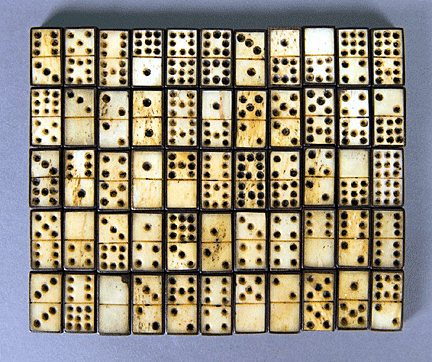
During the 18th century, the game reached Venice and Naples. No one
knows if a set had been brought back from China or whether an Italian
created his own game. The game changed in the translation from Chinese
to the European culture. European sets contained seven additional
dominoes, with six of these representing the values that resulted from
throwing a single die with the other half of the tile left blank, and
the seventh domino representing the blank-blank (0–0) combination. By
the late 18th century, the game of dominoes had arrived in Britain from
France where it became popular in inns and taverns.
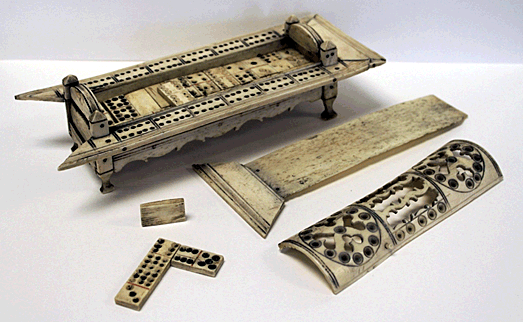
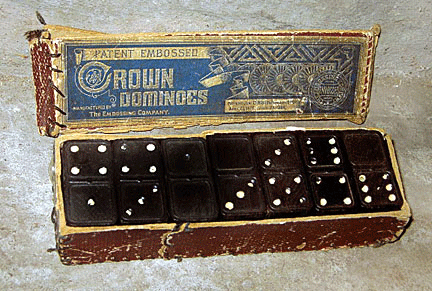 The
word "domino" probably came from the Latin word dominus, meaning “the
master of the house.” This evolved through French, then English to
domino. The word “domino” first referred to a type of monk’s hood, then
to a black hooded masquerade costume with a white mask worn during the
Venetian Carnival, then to the mask itself, and finally to one of the
pieces in the domino set, namely the one-on-one tile. The
word "domino" probably came from the Latin word dominus, meaning “the
master of the house.” This evolved through French, then English to
domino. The word “domino” first referred to a type of monk’s hood, then
to a black hooded masquerade costume with a white mask worn during the
Venetian Carnival, then to the mask itself, and finally to one of the
pieces in the domino set, namely the one-on-one tile.
The game moved from Italy to France in the early 18th Century and became
a fad. By the late 18th century, France began producing two types of
domino puzzles. In the first, a person placed tiles on a given pattern
in such a way that the ends matched. In the second type, a person places
tiles on a given pattern based on arithmetic sums of the pips, usually
totals of lines of tiles and tile halves.
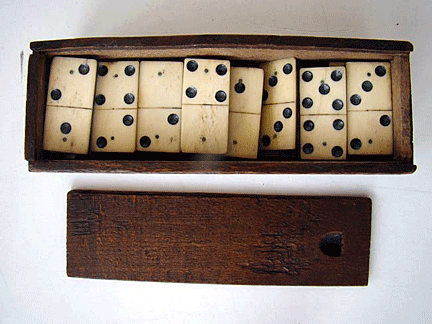 European-style
dominoes are rectangular tiles of wood or ivory that are twice as long
as they are wide. Each has a line dividing its face with two square
ends. Each end has a number of spots called pips that range from one to
six. There’s a single tile for each combination of the faces of a pair
of dice. The backs of the dominoes in a set are either blank or had a
common design. The domino gaming pieces make up a domino set, sometimes
called a deck or pack. The traditional domino set consists of 28
dominoes, featuring all combinations of spot counts between zero and
six. A domino set is a generic gaming device, similar to playing cards
or dice, in that a variety of games can be played with a set. European-style
dominoes are rectangular tiles of wood or ivory that are twice as long
as they are wide. Each has a line dividing its face with two square
ends. Each end has a number of spots called pips that range from one to
six. There’s a single tile for each combination of the faces of a pair
of dice. The backs of the dominoes in a set are either blank or had a
common design. The domino gaming pieces make up a domino set, sometimes
called a deck or pack. The traditional domino set consists of 28
dominoes, featuring all combinations of spot counts between zero and
six. A domino set is a generic gaming device, similar to playing cards
or dice, in that a variety of games can be played with a set.
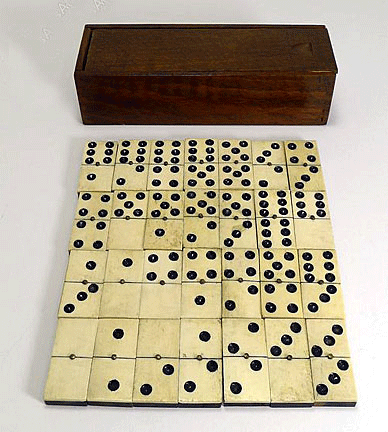 Players
through the centuries have called dominoes "bones" because the earliest
ones were made from animal bones or ivory. In addition to "bones",
dominoes are also called "tiles", "stones", or "men." The earliest
dominoes, made from ivory inlaid of with ebony pips, .are among the most
sought-after and rarest domino sets. Also, farmers in 19th-century rural
England used ivory dominoes rountinely in the settling of disputes over
traditional grazing boundaries and commonly referred to them as "bonesticks." Players
through the centuries have called dominoes "bones" because the earliest
ones were made from animal bones or ivory. In addition to "bones",
dominoes are also called "tiles", "stones", or "men." The earliest
dominoes, made from ivory inlaid of with ebony pips, .are among the most
sought-after and rarest domino sets. Also, farmers in 19th-century rural
England used ivory dominoes rountinely in the settling of disputes over
traditional grazing boundaries and commonly referred to them as "bonesticks."
Tiles are generally named after their two values. Deuce-five or
five-deuce are alternative ways of describing the tile with the values
two and five. Tiles that have the same value on both ends are called
doubles. Players refer to them as double-zero, double-one, etc. Tiles
with two different values are called singles. The most common domino
sets commercially available are double six, with 28 tiles, and double
nine, with 55 tiles.
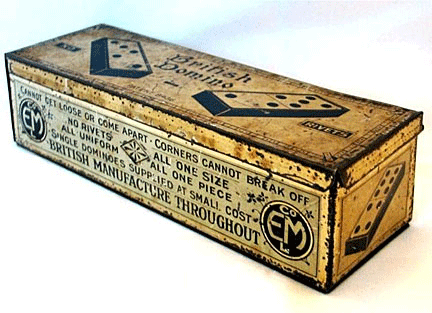 Modern
commercial domino sets are usually made of synthetic materials, such as
ABS or polystyrene plastics, or Bakelite and other phenolic resins. Many
approximate the look and feel of ivory while others use colored or even
translucent plastics to achieve a more contemporary look. Modern sets
also commonly use a different color for the dots of each different end
value—one-spots might have black pips while two-spots might be green,
three red, etc.—to make it easier to find matching ends. Modern
commercial domino sets are usually made of synthetic materials, such as
ABS or polystyrene plastics, or Bakelite and other phenolic resins. Many
approximate the look and feel of ivory while others use colored or even
translucent plastics to achieve a more contemporary look. Modern sets
also commonly use a different color for the dots of each different end
value—one-spots might have black pips while two-spots might be green,
three red, etc.—to make it easier to find matching ends.
It’s amazing how many forms of the game can be played with just 28
dominoes. In addition to the basics like the draw game and the block
game, there are games with unusual names like Sebastopol, Bergin, Rounce,
Sniff, All Fives, Fives & Threes, and Flower and Scorpion.
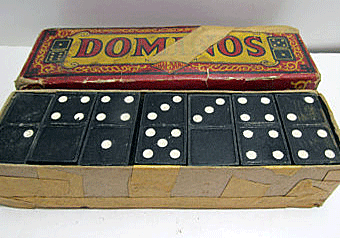 While
wooden dominoes are the most commonly found, the best ones are made of
oblong pieces of ivory, with ebony backs. One hundred years ago, a set
of polished bone dominoes in a mahogany box would have cost as much as
$4, while ordinary bone dominoes sold for as little as 50 cents. While
wooden dominoes are the most commonly found, the best ones are made of
oblong pieces of ivory, with ebony backs. One hundred years ago, a set
of polished bone dominoes in a mahogany box would have cost as much as
$4, while ordinary bone dominoes sold for as little as 50 cents.
Dominoes are an affordable collectible. Only the best ebony and bone
sets sell for $100 or so today. Celluloid sets from the 1930s, made by
the Elkloid Company of Providence, Rhode Island, sell for around half
that. Other sets, tied to special events like world’s fairs, can go for
much more. And the more common sets like the one used above sell for
very little.
<
Back to Readers Ask Archives
Next Article > |
